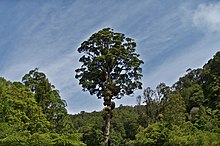Metrosideros robusta
| Northern rātā | |
|---|---|
 |
|
| A Northern rātā towers above the forest at Kaitoke Regional Park, Wellington | |
| Scientific classification | |
| Kingdom: | Plantae |
| (unranked): | Angiosperms |
| (unranked): | Eudicots |
| (unranked): | Rosids |
| Order: | Myrtales |
| Family: | Myrtaceae |
| Genus: | Metrosideros |
| Species: | M. robusta |
| Binomial name | |
|
Metrosideros robusta A.Cunn. |
|
Northern rātā (Metrosideros robusta) is a huge forest tree endemic to New Zealand. It grows up to 25 metres (82 ft) or taller, and usually begins its life as a hemiepiphyte high in the branches of a mature forest tree; over centuries the young tree sends descending and girdling roots down and around the trunk of its host, eventually forming a massive, frequently hollow pseudotrunk composed of fused roots. In disturbed ground, or where there are gaps in the forest cover, Northern rātā will grow on the ground with a normal but short trunk.
Northern rātā is found in the North Island from Te Paki in the north to Wellington in the south. Formerly widespread, it is now uncommon over large parts of its former range, and is no longer found in Hawkes Bay. In the South Island, Northern rātā is common from Nelson to Greymouth and Hokitika. It reaches its southern limit near Lake Mahinapua at 42°4′ South latitude. The natural habitat is forest along the coasts and in the lowlands. In some parts of its range Northern rātā occurs in montane forest. Formerly, with rimu (Dacrydium cupressinum) it was a dominant tree in a forest type known as rimu/rātā forest.
Northern rātā is a massive tree, easily distinguished from other Metrosideros species by its small, leathery, dark green leaves which are 25-50mm long by 15-25mm wide, and have a distinct notch at the tip. Young growth is generally pink and covered in fine rust-coloured hairs that are gradually shed as the foliage ages but tends to persist at the midrib and in the vicinity of the leaf base. The flowers, borne in sprays on the tips of branches, are a mass of dark scarlet stamens. Flowering peaks between November and January, and seeds take a year or slightly more to ripen. The bark is usually brown or grey-brown and rather corky and provides an ideal stratum for the roots of epiphytic plants such as Astelia species and Freycinetia banksii (kiekie). The wood is reddish brown, and the manner of its growth results in a twisted grain.
...
Wikipedia
